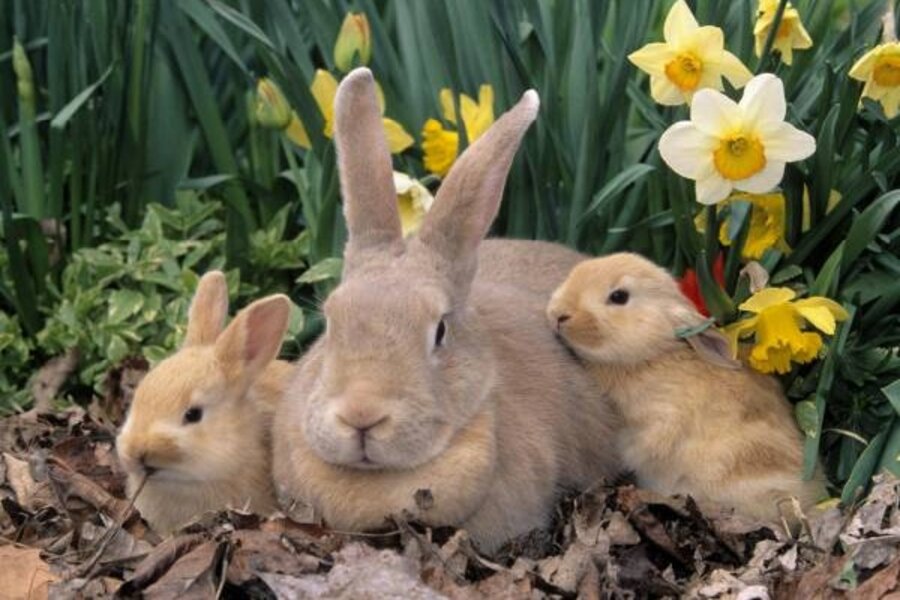How to keep your bulbs safe from deer, rabbits, and other pests
Loading...
Bulbs are perfect, self-contained packages for gardeners. They're equipped with everything necessary to make flowers grow and bloom. Problem is, that makes them a prize for predators, too.
"The perfect lunch box," says Leonard Perry, an extension professor with the University of Vermont. "Put them in the ground this fall and I guarantee you the plant pests will come."
But there are ways to minimize animal damage, and it begins by not underestimating your enemies. Squirrels, chipmunks, rabbits, deer, mice, voles, moles and the many other critters that feast on flower bulbs are crafty. Observant, too.
"Just the fact you're disturbing the earth is a tip-off," Mr. Perry says. "These guys are curious. They'll know something is going on and come to investigate. Once they discover the newly planted bulbs, they'll assume it's food for getting them through winter and there you go. So much for any spring flower displays."
Deer and rabbits like grazing on the tender stems as they surface in early spring. Squirrels, chipmunks, voles and moles, among others, often dine underground. That requires designing a bulb defense in layers.
Here are some proven deterrents. For best results, use them in combination:
— Pest-resistant bulbs. Tulips are deer magnets but other, less-appetizing bulbs are ignored, says Becky Heath, co-owner of Brent and Becky's Bulbs in Gloucester, Va. "In populated areas, where hunting is dangerous and there are no natural predators, deer have become brazen, going right up to the front door to eat something in a pot on a porch," she says. "Choose plants that either taste bad or are (naturally) poisonous." Inter-planting daffodils or alliums, both deer-resistant bulbs, among the more delectable tulips also can be effective.
— Fencing, wire covers, cages and other barriers. Voles, moles and chipmunks are notorious for tunneling their way to bulbs, shrubs and tree roots. "Put a wire mesh cage around them when you plant," Perry says. Fencing is expensive but it will keep deer out of the garden. Build them at least 7 feet high, however, since deer are excellent jumpers. An electric fence is another garden option.
— Unpleasant smells and flavors. "We put bulbs in a plastic bucket and spray them with something that tastes nasty (but) that's not necessarily poisonous," Ms. Heath says. "Let the spray dry and then plant the bulbs. For insurance, we often spray the ground when the new shoots begin to emerge." Many such repellents are sold and most come with strict guidelines for their use. "We usually get people to check with their local extension agent to see what's allowed in each area," Heath says.
— Lights, sprinklers, and barking dogs. Motion detectors attached to water sprinklers and spotlights can be effective. "A tethered dog often works," Perry says. "But it doesn't take long for deer to learn the length of the tether and ignore it."
Other ideas:
Try planting closer to the house or giving bulb-eating animals a distant, alternative garden of their own.
Shooting and poisons are the ultimate sanctions, but both come with safety concerns: Both risk injury or damage beyond the intended target.
"I don't like using poisons even if you don't have kids or pets," Perry says. "They can work their way into the food chain and get into edibles. I'd much rather use biological controls such as burying bulbs with something unappetizing like ground up shells."
Trapping (with a Havahart trap) is yet another alternative, although many communities have rules against relocating wild critters. Check with City Hall before making any moves.
Successfully controlling animal pests around the yard will depend on your timing, methods and resolve. Be aware that what may have worked previously for you or a neighbor may not work again. "Use a few different things in different areas to stay ahead of the game," Perry says.
Editor’s note: For more on gardening, see the Monitor’s main gardening page, which offers articles on many gardening topics. Also, check out our blog archive and our RSS feed. You may want to visit Gardening With the Monitor on Flickr. Take part in the discussions and get answers to your gardening questions. If you join the group (it’s free), you can upload your garden photos and enter our contests.





